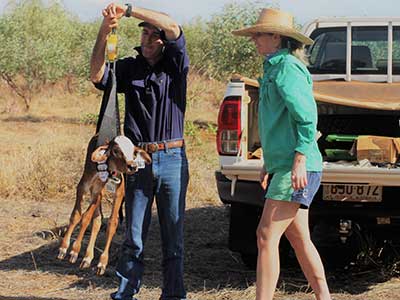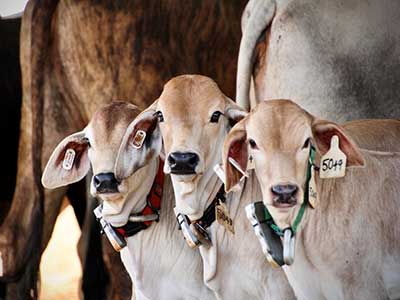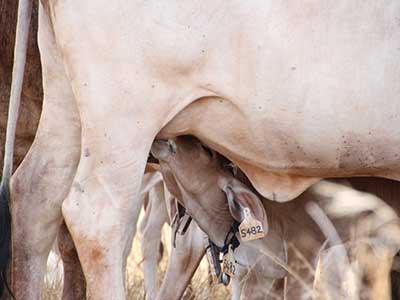Remotely detecting cow and calf behaviours to alert producers to key production outcomes
The uSuckle project is well underway at the Katherine Research Station, using remotely monitored devices (such as accelerometers and GPS trackers) to detect maternal behaviours associated with calf suckling events in first-lactation cows. The Northern Territory’s Department of Industry, Tourism and Trade leads the project in partnership with Queensland Alliance for Agriculture and Food Innovation, the University of Queensland (UQ) and CSIRO.
Funded by Meat and Livestock Australia, the focus of this research is to test and develop the concept that remote monitoring of cow and calf behaviours can alert producers to key production outcomes (such as a successful calving event), suckling length and patterns, or, if suckling prematurely stops, a possible calf loss event.
While dodging COVID-19 lockdowns in Katherine last October, Dr Kieren McCosker (UQ), Professor Michael McGowan (UQ), Greg Bishop-Hurley (CSIRO) and the department staff inducted 30 pregnant maiden heifers due to calve mid-November into the trial. The cows were tagged with a Ceres accelerometer tag and fitted with an eGrazor collar, which contains a GPS, accelerometer and other mechanics that allow streaming and storage of data from the Ceres tags. Birth sensors were also inserted into the vagina, which detect the birth events and then relay the birth event to the research team. Each of these remote monitoring systems on the cattle communicate to a portable 8m high tower located in close proximity (<1km) to the trial paddock.
Shortly after each calf was born, they were caught, weighed and visually assessed for sex, colour and any additional comments (figure 1). The average weight of calves close to birth was 27.3kg. Each calf was tagged with ID tags and a Ceres accelerometer tag (figure 2). A dog collar placed around their neck has a device attached that assists with streaming and storing Ceres tag accelerometer data. Over the next 4 months, the mob was monitored to collect visual data to correlate with the remotely monitored data accumulating from GPS collars and Ceres tags. Visual data was collected through many hours spent in the paddock filming different behaviours, including suckling, standing and ruminating (figure 3). The growth of calves and weight changes in cows was monitored by weighing the cattle once a fortnight. The pre-weaning average daily gain for calves is 0.65kg/day.
Utilising technology such as GPS collars and accelerometer tags in research projects such as uSuckle are vital stepping stones towards scrutinising calf mortality, which is one of the biggest production issues in the northern Australian beef industry.
For further information, contact Elle Fordyce on 08 8973 9730 or Georgia Glasson on 08 8973 3860.



